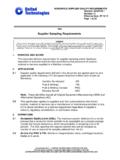Transcription of Statement of Financial Accounting Standards No. 107
1 Statement of Financial Accounting Standards No. 107. FAS107 Status Page FAS107 Summary Disclosures about Fair Value of Financial Instruments December 1991. Financial Accounting Standards Board of the Financial Accounting Foundation 401 MERRITT 7, BOX 5116, NORWALK, CONNECTICUT 06856-5116. Copyright 1991 by Financial Accounting Standards Board. All rights reserved. No part of this publication may be reproduced, stored in a retrieval system, or transmitted, in any form or by any means, electronic, mechanical, photocopying, recording, or otherwise, without the prior written permission of the Financial Accounting Standards Board. Page 2. Statement of Financial Accounting Standards No. 107. Disclosures about Fair Value of Financial Instruments December 1991. CONTENTS. Paragraph Numbers Introduction .. 1 2. Standards of Financial Accounting and Reporting: Definitions and Scope.
2 3 9. Disclosures about Fair Value of Financial Instruments .. 10 15. Effective Dates and Transition .. 16 17. Appendix A: Examples of Procedures for Estimating Fair Value .. 18 29. Appendix B: Illustrations Applying the Disclosure Requirements about Fair Value of Financial Instruments .. 30 33. Appendix C: Background Information and Basis for Conclusions .. 34 88. Page 3. FAS 107: Disclosures about Fair Value of Financial Instruments FAS 107 Summary This Statement extends existing fair value disclosure practices for some instruments by requiring all entities to disclose the fair value of Financial instruments, both assets and liabilities recognized and not recognized in the Statement of Financial position, for which it is practicable to estimate fair value. If estimating fair value is not practicable, this Statement requires disclosure of descriptive information pertinent to estimating the value of a Financial instrument.
3 Disclosures about fair value are not required for certain Financial instruments listed in paragraph 8. This Statement is effective for Financial statements issued for fiscal years ending after December 15, 1992, except for entities with less than $150 million in total assets in the current Statement of Financial position. For those entities, the effective date is for fiscal years ending after December 15, 1995. INTRODUCTION. 1. The FASB added a project on Financial instruments and off-balance-sheet financing to its agenda in May 1986. The project is expected to develop broad Standards to aid in resolving existing Financial Accounting and reporting issues and other issues likely to arise in the future about various Financial instruments and related transactions. 2. Because of the complexity of the issues about how Financial instruments and transactions should be recognized and measured, the Board decided that, initially, improved disclosure of information about Financial instruments is necessary.
4 The first disclosure phase was completed in March 1990 with the issuance of FASB Statement No. 105, Disclosure of Information about Financial Instruments with Off-Balance-Sheet Risk and Financial Instruments with Concentrations of Credit Risk. The second phase, which resulted in this Statement , considers disclosures about fair value of all Financial instruments, both assets and liabilities recognized and not recognized in the Statement of Financial position, except those listed in paragraph 8. Copyright 1991, Financial Accounting Standards Board Not for redistribution Page 4. Standards OF Financial Accounting AND REPORTING. Definitions and Scope 3. A Financial instrument is defined as cash, evidence of an ownership interest in an entity, or a contract that both: a. Imposes on one entity a contractual obligation 1 (1) to deliver cash or another Financial instrument 2 to a second entity or (2) to exchange other Financial instruments on potentially unfavorable terms with the second entity b.
5 Conveys to that second entity a contractual right 3 (1) to receive cash or another Financial instrument from the first entity or (2) to exchange other Financial instruments on potentially favorable terms with the first entity. 4. The definition in paragraph 3 is essentially the same as that in paragraph 6 of Statement 105, which is hereby amended to conform to this Statement . Appendix A of Statement 105. provides examples of instruments that are included in and excluded from the definition of a Financial instrument. 5. For purposes of this Statement , the fair value of a Financial instrument is the amount at which the instrument could be exchanged in a current transaction between willing parties, other than in a forced or liquidation sale. If a quoted market price is available for an instrument, the fair value to be disclosed for that instrument is the product of the number of trading units of the instrument times that market price.
6 6. Under the definition of fair value in paragraph 5, the quoted price for a single trading unit in the most active market is the basis for determining market price and reporting fair value. This is the case even if placing orders to sell all of an entity's holdings of an asset or to buy back all of a liability might affect the price, or if a market's normal volume for one day might not be sufficient to absorb the quantity held or owed by an entity. 7. This Statement requires disclosures about fair value for all Financial instruments, whether recognized or not recognized in the Statement of Financial position, except for those specifically listed in paragraph 8. It applies to all entities. It does not change any requirements for recognition, measurement, or classification of Financial instruments in Financial statements.
7 8. The disclosures about fair value prescribed in paragraphs 10-14 are not required for the following: Copyright 1991, Financial Accounting Standards Board Not for redistribution Page 5. a. Employers' and plans' obligations for pension benefits, other postretirement benefits including health care and life insurance benefits, employee stock option and stock purchase plans, and other forms of deferred compensation arrangements, as defined in FASB. Statements No. 35, Accounting and Reporting by Defined Benefit Pension Plans, No. 87, Employers' Accounting for Pensions, No. 106, Employers' Accounting for Postretirement Benefits Other Than Pensions, and No. 43, Accounting for Compensated Absences, and APB. Opinions No. 25, Accounting for Stock Issued to Employees, and No. 12, Omnibus Opinion 1967. b. Substantively extinguished debt subject to the disclosure requirements of FASB Statement No.
8 76, Extinguishment of Debt, and assets held in trust in connection with an in-substance defeasance of that debt c. Insurance contracts, other than Financial guarantees and investment contracts, as discussed in FASB Statements No. 60, Accounting and Reporting by Insurance Enterprises, and No. 97, Accounting and Reporting by Insurance Enterprises for Certain Long-Duration Contracts and for Realized Gains and Losses from the Sale of Investments d. Lease contracts as defined in FASB Statement No. 13, Accounting for Leases (a contingent obligation arising out of a cancelled lease and a guarantee of a third-party lease obligation are not lease contracts and are included in the scope of this Statement ). e. Warranty obligations and rights f. Unconditional purchase obligations as defined in paragraph 6 of FASB Statement No.
9 47, Disclosure of Long-Term Obligations g. Investments accounted for under the equity method in accordance with the requirements of APB Opinion No. 18, The Equity Method of Accounting for Investments in Common Stock h. Minority interests in consolidated subsidiaries i. Equity investments in consolidated subsidiaries j. Equity instruments issued by the entity and classified in stockholders' equity in the Statement of Financial position. 9. Generally accepted Accounting principles already require disclosure of or subsequent measurement at fair value for many classes of Financial instruments. Although the definitions or the methods of estimation of fair value vary to some extent, and various terms such as market value, current value, or mark-to-market are used, the amounts computed under those requirements satisfy the requirements of this Statement and those requirements are not superseded or modified by this Statement .
10 Disclosures about Fair Value of Financial Instruments 10. An entity shall disclose, either in the body of the Financial statements or in the accompanying notes, the fair value of Financial instruments for which it is practicable to estimate that value. An entity also shall disclose the method(s) and significant assumptions used to estimate the fair value of Financial instruments. 11. Quoted market prices, if available, are the best evidence of the fair value of Financial Copyright 1991, Financial Accounting Standards Board Not for redistribution Page 6. instruments. If quoted market prices are not available, management's best estimate of fair value may be based on the quoted market price of a Financial instrument with similar characteristics or on valuation techniques (for example, the present value of estimated future cash flows using a discount rate commensurate with the risks involved, option pricing models, or matrix pricing models).









